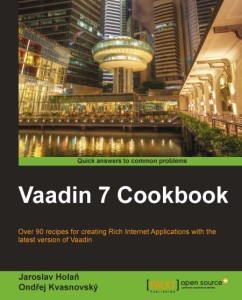My Vaadin application on Google’s AppEngine (FCTR.be), has been doing remarkably well. Which is why I started looking into upgrading it from Vaadin 6.8 to 7. So when Packt Publishing gave me the opportunity to review their new Vaadin 7 Cookbook, it was hard to say no.
 Vaadin 7 is a major upgrade. The new version removes many rough edges that existed in the older versions. However, this also means it’s not compatible with older versions. I have been on the fence about upgrading for quite some time, but the cookbook gave me the last push to go ahead.
Vaadin 7 is a major upgrade. The new version removes many rough edges that existed in the older versions. However, this also means it’s not compatible with older versions. I have been on the fence about upgrading for quite some time, but the cookbook gave me the last push to go ahead.
The Vaadin 7 Cookbook, written by Jaroslav Holan and Ondrej Kvasnovský, is not a step by step guide to getting started with Vaadin. For that, Vaadin’s own tutorials and book are more than enough. No need to buy another book.
So why would you buy the cookbook? There are a few reasons:
- It contains many recipes that solve day-to-day problems you will encounter when developing a Vaadin application. A little experience with Vaadin and a little more experience with Java web applications is certainly going to help you enjoy the book.
- The free Vaadin book hides much of the very interesting and useful functionality in the advanced chapters in the back. This cookbook puts them in the spotlight and immediately explains why you need to know about them (for instance, the Navigator)
- Throughout the book, the authors give their opinion on what’s the best way to tackle a problem. In fact, the architecture chapter is almost exclusively a summary of good ideas.
The book starts with how you can integrate Vaadin in your existing workflow, using Maven, Gradle and few choice frameworks. Mostly Spring and Grails are covered, but there’s also a recipe on getting started with Vaadin in Scala.
From my own experience with the ActionScript Graphing Cookbook, I know writing good recipes, that both educate and help in actual real life is a difficult balance. I think the authors did a very good job at that.
Especially the later chapters contain many recipes that you will be able to refer back to once you’ve actually got that problem. They also contain many useful tips and suggestions that you can use in any Vaadin application (eg, I didn’t know about the SafeHtml utilities).
So while you might be tempted to just glance over the book at first, it’s definitely worth a read-through to pick up on all of the authors insights and practical knowledge. Time permitting, I will probably be going over a few individual recipes in the future as I upgrade my own web application.
Conclusion
If you’ve got a little experience with Vaadin and want a shortcut to quickly get up to speed with the latest Vaadin 7, this is a great choice. The cookbook can both be used as a quick primer of the major functionality. And if you need to execute certain tasks in the future, it’s also a solid reference.
Varied recipes cover most of the things you’d want to do with Vaadin.